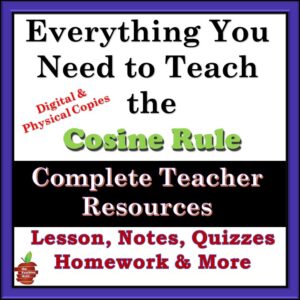Voronoi sounds like an awful word and students often react as though it’s an awful subject. But, it doesn’t have to be that way. In this post, I will share with you some ideas, best practices, and resources to make teaching Voronoi Diagrams a snap!
I teach Voronoi Diagrams for IB SL mathematics, but the concepts and practices are the same, regardless of curriculum. Students will need to understand two main ideas, and then be creative problem solvers fluent in linear equations and perpendicular bisectors.
We will walk through some of the resources and strategies used to help students learn Voronoi Diagrams in this post.
Step 1: Reading

Reading takes time, and time is required when learning something new. I believe reading, and taking quality notes while doing so, is a great way to introduce the subtle concepts of Voronoi Diagrams to students.
You can download a set of notes, with some practice problems, by clicking on the icon to the left. Either print this (less optimal), or set an assignment in Google Classroom where students are given the reading assignment and are responsible to answer the questions included in the reading.
There is a Google Forms resource that has the reading and questions embedded that can be assigned. You can learn more about that at the bottom of the page.
Step 2: Lesson, Group Problems, Practice
![]() Since the students having already done some reading and practice the lesson does not have to be lecture. A PowerPoint is a great way to start a Socratic dialogue with students. Embedding quality questions throughout, as well as opportunities for practice, is a great way to have a lively discussion and powerful learning experience for students.
Since the students having already done some reading and practice the lesson does not have to be lecture. A PowerPoint is a great way to start a Socratic dialogue with students. Embedding quality questions throughout, as well as opportunities for practice, is a great way to have a lively discussion and powerful learning experience for students.
In the lesson, have students articulate the key concepts. The main idea is that these key concepts are what drive the decision making process when solving the types of problems that use Voronoi Diagrams.
Have a quality set of practice problems to assign students. Your textbook probably has good problems. If not, we offer some in the Teacher Tool Box for Voronoi Diagrams described at the bottom of the page. Give plenty of opportunity to students to ask about the problems, and spend a bit of class time reviewing the practice over the next day or two.
Step 3: Short Assessment
 Frequent, but low-risk assessments are a key component in student success. Assessments must be frequent because it keeps the urgency in student behavior. The reward or punishment for bad student behavior and low level engagement is near. Young people need this structure.
Frequent, but low-risk assessments are a key component in student success. Assessments must be frequent because it keeps the urgency in student behavior. The reward or punishment for bad student behavior and low level engagement is near. Young people need this structure.
The assessments should be short, 10 to 15 minutes at the most. We have a lot to do and cannot spend too much time assessing students.
The assessments should be low-risk, meaning small point value. Students are nervous about the grade they receive on an assessment more than they are worried about what an assessment means to their over-all grade. Yes, they care about both, but they get emotional over the immediate result, “I got an A,” or, “I got an F.” That means more than this quiz was only worth 4 points, so over the course of the semester, it’s almost nothing.
I give Bellwork quizzes twice a week, on Tuesday and Thursday, to start class. There are no re-takes or second chances, and the tests are always given after ample time for questions has passed. For example, on Thursday I would assign the reading. On Monday we would do the lesson and the practice would be assigned. The practice would be due Wednesday, and the Bellwork quiz would be given on Thursday.
Revisit Periodically
If students seem to struggle with a particular skill or problem solving procedure, revisit that regularly. Put one or two of those types of problems on every single quiz until students finally do the work required to master that skill.
Even if students are very proficient on all things dealing with Voronoi Diagrams, have a problem for Bellwork, or thrown in a homework assignment, and definitely on an assessment every once in a while.
This topic is great because it draws on some many elements of mathematics. Students are forced to decompartmentalize their understanding and apply concepts of Algebra and Geometry simultaneously. This is a great avenue to keep students sharp and promote improved problem-solving skills.
Having Trouble with Resources and Time?
We put it all together for you in one easy document. Learn more here.
This “Teacher’s Toolbox,” for Voronoi diagrams includes everything you need to introduce the topic, facilitate the learning, challenge and support students, and then assess them on their performance. It’s all put together and ready to go!
You just need to download the resources and go!


